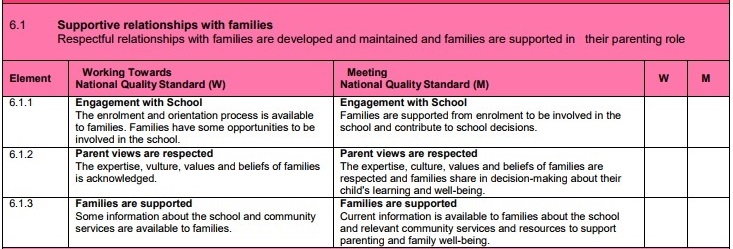Title Page
-
Audited by
-
Audited on
-
Location
Internal Audit
QA1 - Educational Program and Practice
1.1 PROGRAM: The educational program enhances each child's learning and development
-
-
1.1.1 National Quality Standard
-
1.1.2 Child-Centered
-
1.1.3 Program Learning Opportunities
1.2 PRACTICE: Educators facilitate and extend each child’s learning and development
-
-
1.2.1 Intentional Teaching
-
1.2.2 Responsive Teaching and Scaffolding
-
1.2.3 Child Directed Learning
1.3 ASSESSMENT & PLANNING: Educators and coordinators take a planned and reflective approach to implementing the program for each child
-
-
1.3.1 Assessment and planning cycle
-
1.3.2 Critical Reflections
-
1.3.3 Information for families
QA2 - Children’s Health and Safety
2.1 HEALTH: Each child’s health and physical activity is supported and promoted.
-
-
2.1.1 Well-being and comfort
-
2.1.2 Health practices and procedures
-
2.1.3 Healthy lifestyle
2.2 SAFETY: Each child is protected
-
-
2.2.1 Supervision
-
2.2.2 Incident and emergency management
-
2.2.3 Child Protection
QA3 - Physical Environment
3.1 DESIGN: The design of the facilities is appropriate for the operation of the school
-
-
3.1.1 Fit for purpose
-
3.1.2 Upkeep
3.2 USE: The school environment is inclusive, promotes competence and supports exploration and play based learning.
-
-
3.2.1 Inclusive environment
-
3.2.2 Resources support play-based learning
-
3.2.3 Environmentally responsible
QA4 - Staffing Arrangements
4.1 ORGANIZATION OF EDUCATORS: Staffing arrangements enhance children’s learning and development
-
-
4.1.1 Organization of educators
-
4.1.2 Continuity of staff
4.2 PROFESSIONALISM: Management, educators and staff are collaborative, respectful and ethical
-
-
4.2.1 Professional Collaboration
-
4.2.2 Professional Standards
QA5 - Relationships with Children
5.1 RELATIONSHIPS BETWEEN EDUCATORS AND CHILDREN: Respectful and equitable relationships are maintained with each child.
-
-
5.1.1 Positive educator to child interactions
-
5.1.2 Dignity and rights of the child.
5.2 RELATIONSHIP BETWEEN CHILDREN: Each child is supported to build and maintain sensitive and responsive relationships
-
-
5.2.1 Collaborative learning
-
5.2.2 Self-regulation
QA6 - Collaborative Partnerships with Families and Communities
6.1 SUPPORTIVE RELATIONSHIPS WITH FAMILIES: Respectful relationships with families are developed and maintained and families are supported in their parenting role
-
-
6.1.1 Engagement with School
-
6.1.2 Parent views are respected
-
6.1.3 Families are supported
6.2 COLLABORATIVE PARTNERSHIPS: Collaborative partnerships enhance children’s inclusion, learning and well-being.
-
-
6.2.1 Transitions
-
6.2.2 Access and participation
-
6.2.3 Community engagement
QA7 - Governance and Leadership
7.1 GOVERNANCE: Governance supports the operation of a quality school
-
-
7.1.1 Early Years School philosophy and purpose
-
7.1.2 Management systems
-
7.1.3 Roles and responsibilities
7.2 LEADERSHIP: Effective leadership builds and promotes a positive organizational culture and professional learning community.
-
-
7.2.1 Continues improvement
-
7.2.2 Educational Leadership
-
7.2.3 Development of professionals
Audit Completion
-
Completed by (Name and Signature)




















